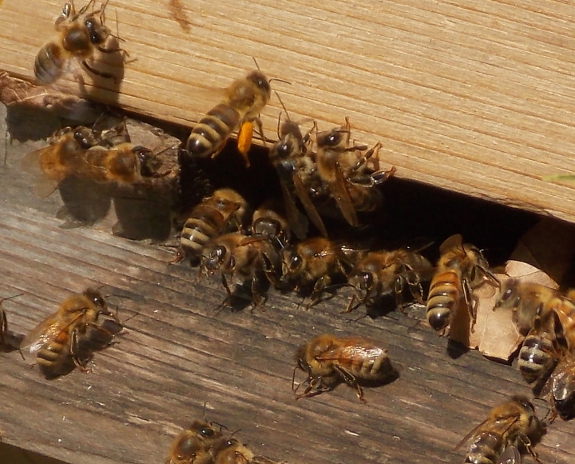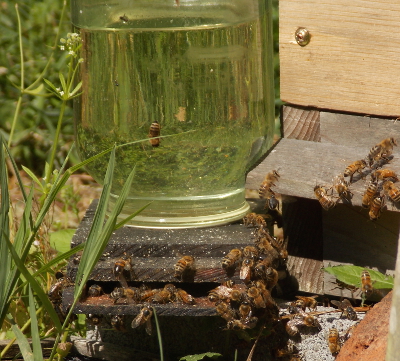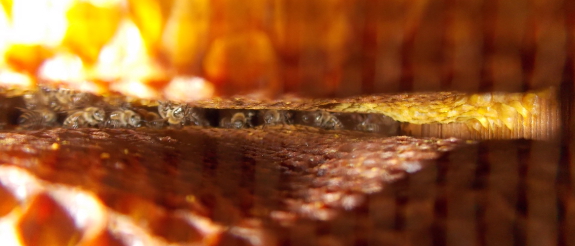
Pollen counts

 Saturday
morning, I decided to amuse myself with a pollen count. No, I'm
not talking about the type of pollen count that allergy sufferers
concern themselves with --- I mean counting how many worker bees were
carrying pollen into each of our hives.
Saturday
morning, I decided to amuse myself with a pollen count. No, I'm
not talking about the type of pollen count that allergy sufferers
concern themselves with --- I mean counting how many worker bees were
carrying pollen into each of our hives.
As I explained in a previous post,
all of the eggs laid by our queen before the hive split should now be
capped brood. So the hypothesis was that I could tell which hive
ended up with the queen by looking for the colony into which workers
were still bringing pollen.
The mother hive location had so many bees coming in and out (top photo)
that my count might be off by a bit, but I think I managed to catch most
of the returning workers. I definitely counted every bee coming into the daughter hive. Here's what I found out:
| Mother Hive |
Daughter Hive |
|
| Time of day |
10:54 am |
11:05 am |
| Length of data collection time |
1 min. 30 sec. |
5 min. 55 sec. |
| # workers entering with pollen |
13 |
19 |
| # workers entering without pollen |
37 |
31 |
| % of workers bringing pollen |
26% |
38% |
| Pollen carriers per minute |
8.7 |
3.2 |
| Notes |
In full sun; lots of bees at feeder |
Sun just starting to hit hive; no bees at feeder |
The conclusion? To
my surprise, both colonies were still bringing home pollen at a
relatively high rate. It looks like my I can't tell which hive has
the queen based on pollen counts after all!

I was interested to see
that the old piece of bee-keeping wisdom --- bees bring in pollen to
feed brood --- seems to be only partially true at best. And it
makes sense to me that a colony would collect pollen whenever the
protein source is available since they'll need to store some for times
of dearth.
It looks like I'll have to keep my eyes open for other signs of queens,
like batches of new workers coming out for test flights. And then
there's my old standby of peering up under the bottom of the hive.
Stay tuned for more investigative reporting from the apiary!
Want more in-depth information? Browse through our books.
Or explore more posts by date or by subject.
About us: Anna Hess and Mark Hamilton spent over a decade living self-sufficiently in the mountains of Virginia before moving north to start over from scratch in the foothills of Ohio. They've experimented with permaculture, no-till gardening, trailersteading, home-based microbusinesses and much more, writing about their adventures in both blogs and books.
Want to be notified when new comments are posted on this page? Click on the RSS button after you add a comment to subscribe to the comment feed, or simply check the box beside "email replies to me" while writing your comment.
